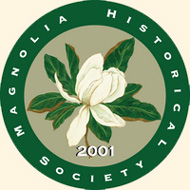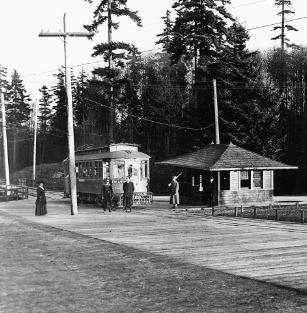by Monica Wooton
President of the Magnolia Historical Society
Then…
In “A Long and Winding Road” from Magnolia: Making More Memories, Magnolia resident Claudia Isquith describes the 4 decades long battle between an early prominent land owner James Clise, the city of Seattle, Magnolia residents against the city and then amongst themselves to get Magnolia Boulevard paved. “The City Council compromised and agreed to a 70-foot graded section; the work was completed on July 30, 1948, with the City contributing $40,422 from the City Street Fund for an 8-inch-thick section of concrete pavement extending from West Emerson Street to West Dravus Street. Other City departments covered the balance of the cost, and the 44 residents were not assessed for the improvement. One of the compromises was no lights on the street”, Isquith reports.

One of the oldest gas stations on Magnolia. A popular place for teens who needed jobs and wanted to work on cars. Owner Al Gray posing by the gas pump at Lawton Service Station at 4420 32nd Avenue West. Courtesy of Wayne Gray family. 1928.
Once that road was finally done in the late 1940’s “street racing” became a pastime of many male Magnolia teens. It had a resurgence in the 60’s and another generation of Magnolia males hit that road once again to race late into the night. “Street racing is a form of unsanctioned and illegal motor car racing which takes place on public roads. Street racing can either be spontaneous or well-planned and coordinated.”

Road work widening Magnolia Boulevard West by the curves continued even after the street racing began.
Seattle Municipal Archives, Engineering Department Photographic Negatives, #44547. October 7, 1953.
With the long, straight stretch finally paved and the street cloaked in darkness some of the most enthusiastic racers came from the car clubs all around Seattle. The Clutchers, The Strokers and the Seattle Custom Club got an idea. Don Jenson, now in his 80’s recalled how he got some white paint and painted a line right across the street, the starting line and finishing line, for a 1/4 mile racecourse. The club members driving mostly flathead fords all “hopped up hot-rods” would, late at night, challenge each other and race at speeds of 75-80 mph for bragging rights. “There was never a scratched fender or an accident.” They ran with modified mufflers so the noise was not a factor, Jenson recalled that the drivers were almost always liars when it came to how fast they went: “Well, the best liars always had the fastest cars, of course.”

Part of the straight stretch of the Boulevard appears in this photo.
Magnolia Boulevard West widening and sewage work.
Seattle Municipal Archives, Engineering Department Photographic Negatives, #18323.
August 3, 1953.
The tradition was revived in the 60’s. When street racing was done on many flat stretches of road late at night. Shilshole was another popular street for teen-age boys in “souped up” cars to match machismo. Rob Hitchings admitted he had participated in the street racing on Magnolia Boulevard back then:
“Yeah. Guilty as charged! My 57 Pontiac wagon was a frequent winner (389 CID with an aftermarket Edelbrock double pumper 600 CFM 4 BBL carb) we even painted white lines across the Boulevard marking off a 1/4 mile and we would have someone with a stop watch time us. We would make a run north then turn around and do another. The races took place mostly on a late Friday PM or early Saturday AM. We would have lookouts for the then one Seattle Police patrol car on Magnolia just north of the big curve at the south end of the Boulevard and another just before the S curves at the north end by the Perkins Lane road. If they saw the police car they would flash their headlights and we would either scatter up the side streets or duck into the overlook parking spots “The Pits” on the Boulevard, short for “Passion Pit” where couples went to “Watch the submarine races”! Really to make-out.
“It was also a way for those of us more serious drag racers to test our cars before taking them to Seattle International Raceway or Arlington for the “Grudge Races” on Saturdays. There were those that just wanted to see how fast Dad’s car could go in that 1/4 mile. It was mostly Magnolia kids though quite a few Queen Anne guys would come because there wasn’t a straight stretch long enough on Queen Anne hill.
“Then there was also a little thing we called “RAT RACING” it was a sort of a high speed follow the leader through the side streets, alleys, etc. that ended up at “The Pits”. There was more organized drag racing down at Golden Gardens I even saw a guy bring an actual dragster down on a trailer and make a run there”.
Now…
The Boulevard remains an unlit street today so those who live there will not have to deal with glaring lights in their views. The days of dragster cars and Magnolia teens hanging out at local gas stations or working on making their cars go faster and spending every dime they had to do it have ceased. Now there are 7 banks in the Village, back then there were 7 gas stations. The races of today are more virtual on electronic gaming devices and the fad of the 40’s and 60’s have seemed to be replaced with a new industry of high tech race tracks and cars. But, in Magnolia and Queen Anne there are lots of stories and memories of the good ole days of Magnolia street racing. Just ask guys like Jo Anderson, Louie Isquith and Lee Zobrist. They have tales to tell. No one had a picture of it! Some say you can still see the faint white paint of the start line if you know where to look.
Sources: Magnolia: Making More Memories, “A Long and Winding Road”, Claudia Isquith, pp, 42-46, Wikipedia, Street Racing; Don Jensen; Rob Hitchings; Magnolia Making More Memories, “Fill ‘er Up”, Gary McDaniel, p. 253; George (Jo) Anderson, Jr.; Dr. Louis Isquith; Lee Zobrist
To order Magnolia History Books: www.magnoliahistocialsociety.org or call 206-284-5480.



